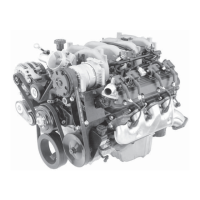WORKHORSE CUSTOM CHASSIS
Service Manual
W SeriesWCC
SECTION
6.2
PAGE
55
Engine Mechanical
W Series Chassis
TOC
© 2006 WorkhorseCustom Chassis — All Rights Reserved
Test Description
The numbers below refer to the step numbers on the diagnostic table.
2. The noise may not be engine related. This step is to verify that the engine is making the noise. If the engine is not
making the noise do not proceed further with this table.
3. The noise may be an internal engine noise. Removing the drive belts one at a time and operating the engine for a
brief period will verify the noise is related to the drive belt. When removing the drive belt the water pump may not be
operating and the engine may overheat. Also DTCs may set when the engine is operating with the drive belts removed.
4. Inspect all drive belt pulleys for pilling. Pilling is the small balls or pills or it can be strings in the drive belt grooves from
the accumulation of rubber dust.
6. Misalignment of the pulleys may be caused from improper mounting of the accessory drive component, incorrect
installation of the accessory drive component pulley, or the pulley bent inward or outward from a previous repair. Test
for a misaligned pulley using a straight edge in the pulley grooves across two or three pulleys. If a misaligned pulley is
found refer to that accessory drive component for the proper installation procedure for that pulley.
10. Inspecting of the fasteners can eliminate the possibility that a wrong bolt, nut, spacer, or washer was installed.
12. Inspecting the pulleys for being bent should include inspecting for a dent or other damage to the pulleys that would
prevent the drive belt from not seating properly in all of the pulley grooves or on the smooth surface of a pulley when the
back side of the belt is used to drive the pulley.
14. This test is to verify that the drive belt tensioner operates properly. If the drive belt tensioner is not operating properly,
proper belt tension may not be achieved to keep the drive belt from slipping which could cause a squeal noise.
15. This test is to verify that the drive belt is not too long, which would prevent the drive belt tensioner from working
properly. Also if an incorrect length drive belt was installed, it may not be routed properly and may be turning an
accessory drive component in the wrong direction.
16. Misalignment of the pulleys may be caused from improper mounting of the accessory drive component, incorrect
installation of the accessory drive component pulley, or the pulley bent inward or outward from a previous repair. Test
for a misaligned pulley using a straight edge in the pulley grooves across two or three pulleys. If a misaligned pulley is
found refer to that accessory drive component for the proper installation procedure for that pulley.
17. This test is to verify that the pulleys are the correct diameter or width. Using a known good vehicle compare the pulley
sizes.
19. Replacing the drive belt when it is not damaged or there is not excessive pilling will only be a temporary repair.

